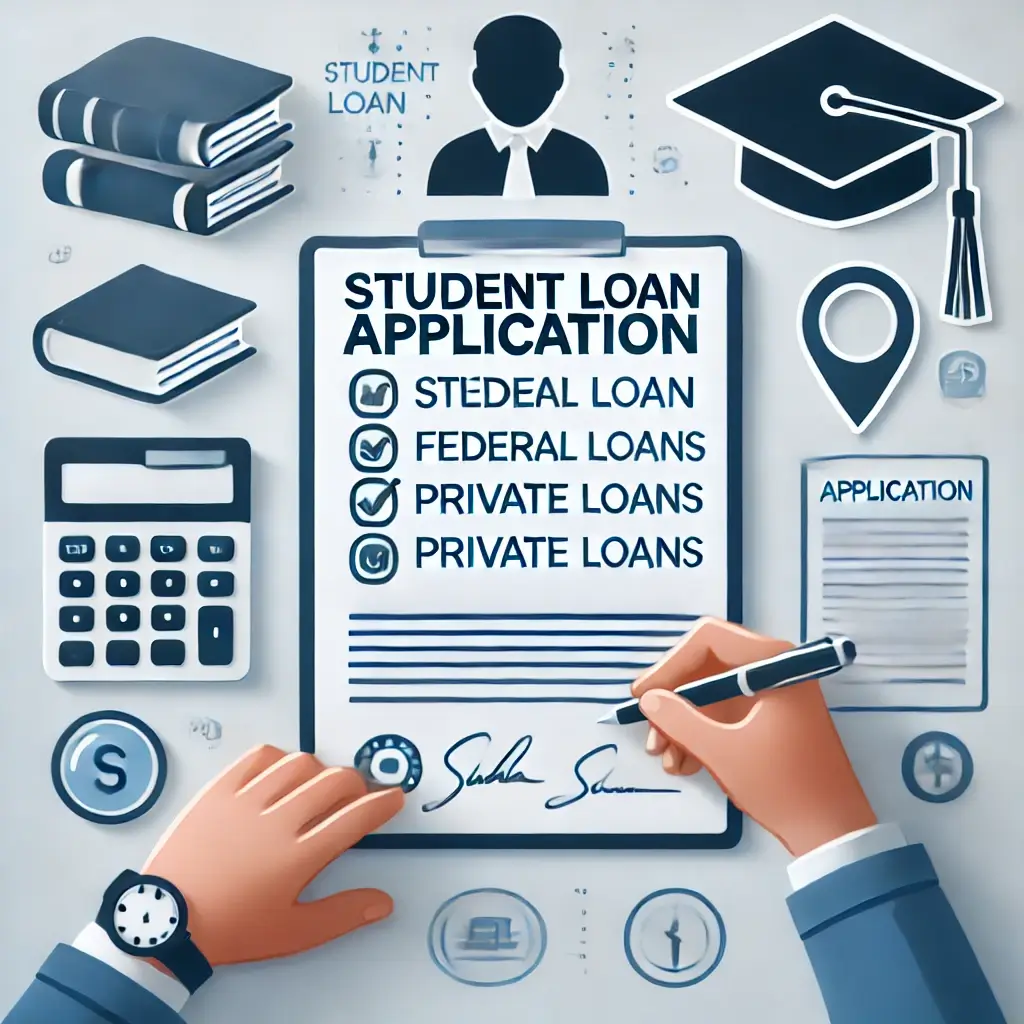Navigating the process of funding your education can feel overwhelming, but student loans offer an effective way to cover tuition and other expenses. Knowing How to Apply for Student Loans ensures you take the right steps to secure the financial support you need for college. This guide will walk you through the entire process, from determining your loan eligibility to submitting your application.
1. Understand the Types of Student Loans
Before you start the application process, it’s important to understand the two main types of student loans: federal and private. Knowing which loan type suits your needs will streamline the application process and help you secure the right funding.
1.1 Federal Student Loans
Federal student loans are offered by the U.S. government and come with several benefits, such as lower, fixed interest rates and flexible repayment options. They’re typically the first choice for students because of these borrower protections.
Types of federal loans include:
- Direct Subsidized Loans: Available to undergraduate students with financial need. The government pays the interest while you’re in school.
- Direct Unsubsidized Loans: Available to undergraduate and graduate students, regardless of financial need.
- Direct PLUS Loans: Available to graduate students and parents of undergraduates. These loans require a credit check.
1.2 Private Student Loans
Private loans are offered by banks, credit unions, and online lenders. They are based on creditworthiness and often require a cosigner. These loans can be useful when federal loans don’t cover the full cost of attendance, but they usually come with higher interest rates and fewer repayment options.
2. Step-by-Step Guide: How to Apply for Federal Student Loans
Federal student loans are the most accessible for most students. Here’s a detailed guide on how to apply for Student Loans through the federal government.
2.1 Complete the FAFSA (Free Application for Federal Student Aid)
The first step in applying for federal student loans is completing the FAFSA. The FAFSA determines your eligibility for federal loans, grants, and work-study programs.
- Where to Apply: Visit the official FAFSA website (fafsa.gov).
- Information Needed: Your Social Security number, tax returns, bank statements, and details on any other financial assets.
- When to Apply: Submit the FAFSA as soon as possible after it becomes available on October 1st. Deadlines vary by state and school, so don’t wait!
2.2 Review Your Student Aid Report (SAR)
After submitting the FAFSA, you’ll receive a Student Aid Report (SAR). This document summarizes your financial information and provides an estimate of your Expected Family Contribution (EFC), which is used to determine your financial aid eligibility.
- Review for Errors: Ensure that all information is correct. If you notice any discrepancies, update your FAFSA immediately.
2.3 Receive Your Financial Aid Offer
Once your FAFSA has been processed, your school’s financial aid office will send you a financial aid offer. This offer outlines the federal loans, grants, and work-study opportunities you qualify for.
- Loan Amounts: The offer will specify the loan amounts available to you, broken down by loan type (e.g., Direct Subsidized or Unsubsidized Loans).
- Grants and Work-Study: Review any non-repayable aid such as grants and work-study.
2.4 Accept the Student Loan
Decide how much of the loan offer you want to accept. You’re not required to accept the full amount, and it’s recommended to borrow only what you need to cover tuition and essential expenses.
- Subsidized vs. Unsubsidized: Accept subsidized loans first, as they cost less in the long run.
- Declining Loans: If you decline or reduce the loan offer, it does not affect your eligibility for future loans.
2.5 Complete Entrance Counseling
If you’re a first-time borrower, you’ll need to complete entrance counseling. This brief online course explains your responsibilities as a borrower and provides essential information about managing student loans.
2.6 Sign the Master Promissory Note (MPN)
The Master Promissory Note (MPN) is a legal document where you agree to the terms of your loan and commit to repaying it. You can sign the MPN electronically on the Federal Student Aid website.

3. Step-by-Step Guide: How to Apply for Private Student Loans
If federal loans don’t cover your full cost of attendance, you may need to explore private student loans. Here’s a guide on How to Apply for Student Loans through private lenders.
3.1 Research and Compare Lenders
Private student loans vary widely in terms of interest rates, repayment options, and borrower requirements. Start by comparing different lenders to find the best rates and terms for your situation.
- Interest Rates: Fixed vs. variable rates. Fixed rates remain the same, while variable rates can change over time.
- Loan Limits: Some lenders allow you to borrow up to the total cost of attendance, while others have caps.
- Repayment Terms: Look for flexible repayment options, such as interest-only payments while in school.
3.2 Prequalify for a Loan
Many lenders allow you to prequalify online by providing basic information such as your income, credit score, and school details. Prequalification gives you an idea of what rates you’ll be offered without affecting your credit score.
3.3 Find a Cosigner (If Needed)
Most private lenders require a cosigner unless you have strong credit or a high income. A cosigner reduces the risk for the lender and can help you secure better rates.
- Who Can Be a Cosigner: Typically a parent or close relative with a strong credit history.
- Cosigner Release: Some lenders allow cosigner release after you’ve made a certain number of on-time payments.
3.4 Submit a Loan Application
Once you’ve chosen a lender, complete the online application. You’ll need to provide:
- Proof of enrollment
- Income verification (for both you and your cosigner, if applicable)
- Social Security numbers
3.5 Review Loan Terms and Sign the Agreement
Once approved, review the loan terms carefully before signing. Pay close attention to the interest rate, repayment schedule, and any fees associated with the loan. After reviewing the terms, sign the loan agreement.
4. Tips for Managing Student Loans After Application
Once you’ve successfully applied for and received your student loans, it’s important to stay on top of repayment and manage your loans responsibly. Here are a few key tips:
4.1 Create a Budget for Repayment
Start planning for repayment early by creating a budget. Make sure you know how much you’ll need to pay each month and factor it into your future financial planning.
4.2 Consider Loan Forgiveness Programs
Federal loans are eligible for forgiveness programs such as Public Service Loan Forgiveness (PSLF). If you plan to work in public service, explore these options to potentially have your loan forgiven.
4.3 Use Loan Management Tools
There are several online tools available to help you manage and track your loans. Set reminders for repayment dates and explore income-driven repayment plans if needed.
Conclusion on How to Apply for Student Loans
Learning How to Apply for Student Loans is a critical part of financing your education. Whether you’re applying for federal or private loans, understanding the process can help you secure the funding you need while making informed financial decisions. By following this step-by-step guide, you can navigate the student loan process with confidence and set yourself up for financial success after graduation.
